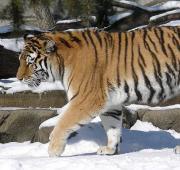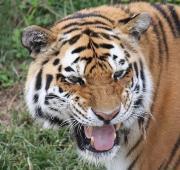 The Siberian tiger (also known as the Amur and the Ussuri tiger) is a large subspecies of tiger, found throughout western and central Asia. The Siberian tiger is the largest species of tiger in the world closely followed by the Bengal tiger, found on the Indian subcontinent.
The Siberian tiger (also known as the Amur and the Ussuri tiger) is a large subspecies of tiger, found throughout western and central Asia. The Siberian tiger is the largest species of tiger in the world closely followed by the Bengal tiger, found on the Indian subcontinent. The Siberian tiger was once found across central and western Asia and throughout Russia, but conflict and deforestation has made the Siberian tiger extinct in much of its native habitat. Today the Siberian tiger's range is restricted to parts of eastern Siberia where it is now a protected species.
The Siberian tiger was once found across central and western Asia and throughout Russia, but conflict and deforestation has made the Siberian tiger extinct in much of its native habitat. Today the Siberian tiger's range is restricted to parts of eastern Siberia where it is now a protected species.


The Siberian tiger is a dominant and carnivorous predator, hunting its prey by stalking it until the Siberian tiger has the opportunity to catch it off guard. Siberian tigers primarily hunt larger mammals including deer, wild boar, cattle and goats.
Due to the size and power of the Siberian tiger, it has no natural predators in its native environment. Humans that hunt the Siberian tiger and habitat loss are the only threats to the Siberian tiger.
After a gestation period of 3 to 4 months, the female Siberian tiger gives birth to up to 5 cubs. Newborn Siberian tiger cubs weigh about 1 kg (2 lb) and are blind and helpless. The mother feeds them milk for about 2 months and then the Siberian tiger cubs are introduced to meat. Siberian tiger cubs depend on their mother for the first 18 months and then they start hunting on their own.
Today, due to habitat loss caused by deforestation, and hunting by human poachers, the Siberian tiger is considered to be an endangered species. Despite being the largest of all the tiger species, there are thought to be less than 500 Siberian tigers left in the wild.

